When Royal Toured Australia in 1936
Pat McCarthy impresses Woodful
by Richard Dwight – Daily News, Saturday 14 Feb 2004
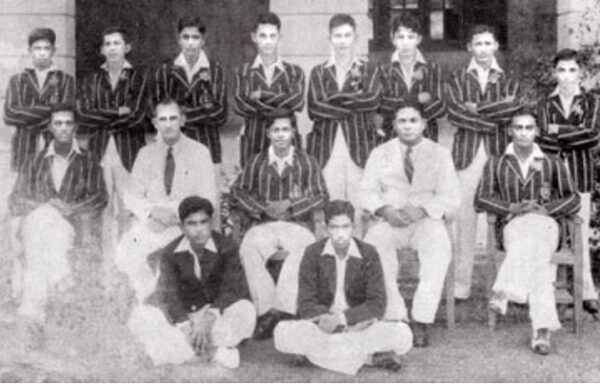
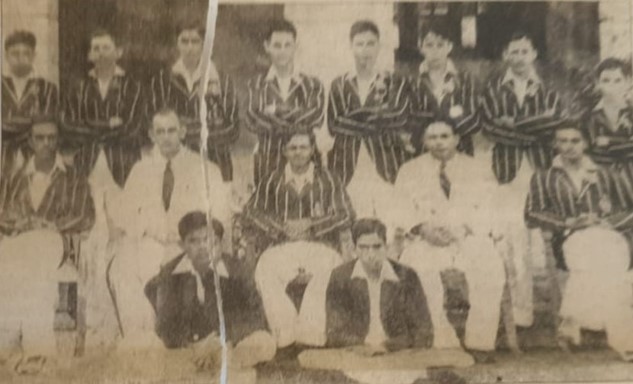
The Royal College cricket team of 1936 which toured Australia.
Standing (L-R): Lucien de Zoysa, Pat McCarthy, S. Pathmanathan, W.B.V. Thiedeman, David Vollenhoven, E.F.E. de Krester, J.W. Subasinghe, D.R.R. Porritt.
Seated (L-R): F.H. de Saram, Mr. L.H.W. Sampson (Principal), Ryle de Soysa (Capt.), Mr. L.V. Gooneratne (Master-in-charge), M. Sivanathan.
Seated on Ground (L-R): A.I. Macan Markar, Robert de Krester.
In the sphere of annual cricket encounters Royal College and S. Thomas’ College have since the series began in 1880 done exceedingly well to arrive at this point of time to notch its 125th encounter next month at the SSC grounds – a veritable landmark indeed in the annals of cricket of these two leading colleges.
A sustained unbroken partnership of 125 years maintained without interruption even during the period of war and otherwise is truly a commendable achievement, that bespeaks of deep commitment and loyalty in the greater cause and common good.
A traditional Big Match of this magnitude and nature, often spoken of as the ‘Battle of the Blues’, has through the years developed a healthy character and identity of its own. So much so, that apart from the cricket played, there is also much fellow feeling amidst festive gaiety and revelry, which draws many to it from here and abroad. Comparatively, therefore, it’s not just another school match, but a major happening, that gives it a right to be regarded as the oldest schools’ cricket encounter of the world, of which not only the two colleges, but the country as a whole, could be proud of.
And so as a run up to this historic match, much has been said and written concerning these two cricket playing colleges, with more nostalgic moments and incidents to come as we get nearer to the date.
One amongst others that dwell in the mind is the venturesome enthusiasm that took hold of the Royal College Cricket team of 1936 – when the cricketers that year eagerly responded to the prospect of making a tour to Australia. This enterprising idea was the brainchild of the far-seeing, visionary Principal of Royal, Mr. L.H.W. Samson.
It was a bold effort in the learning experience, when one realises that travel was confined to sea and the fact that there weren’t proper sophisticated facilities for communications too.
History therefore was created in the annals of Royal College Cricket when as a part of its centenary year celebrations, the college cricket team embarked on a ’45-day’ tour of Australia in March of 1936.
Undoubtedly it was the first time that a school team left the shores of the country and perhaps, a representative side as well from Ceylon itself.
Ryle de Soysa, who had played for Royal from 1934 had the rare privilege and singular honour of leading the side, with Mr. L.V. Gooneratne as Manager and the Principal L.H.W. Sampson
accompanying the team. The members of that historic team were Ryle de Soysa (Capt.), M. Sivanathan, F.H. de Saram, Bunny Thiedeman, S. Pathmanathan, David Vollenhoven, D.R.R. Porritt, Pat McCarthy, E.F.E. de Krester, Lucien de Soysa, A.I. Macan Markar and J.W. Subasinghe.
The team played five matches, drawing four where in some Royal led on the first innings and lost to St. Peter’s College, Adelaide. The most eventful match of the tour was against Melbourne High School where the Principal of Melbourne High and Australian Cricket Captain, W.M. (Bill) Woodful was highly impressed with Pat McCarthy’s batting and fielding and the all-round ability of Keith Miller of his school, which made him say that they were future prospects for their respective countries, while Ryle de Soysa was adjudged the best all-rounder.
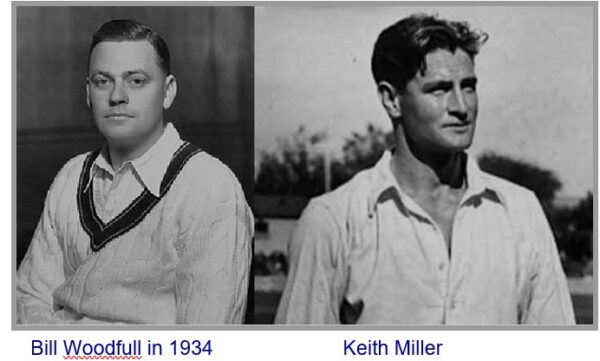
Incidentally Ryle’s brother, Harold de Soysa was the first Ceylonese Anglican Bishop, who played cricket for Royal. The entire Royal squad that Ryle led to Australia, comprised six Burghers, four Sinhalese, two Tamils and a Muslim, verily a cosmopolitan side indeed. It must be mentioned that the fair complexioned Burgher cricketers did lend much colour to the game of cricket with a charisma and aura of his own. And with their customed, assertive and aggressive approach, had the knack of making decisive contributions at crucial moments.
Alas it’s pity they are no longer around now. Most of those who played the game in the good old days, were not only excellent cricketers but
emerged as fine gentleman. And it does us well, to now and then, go back in time, to reminisce over those glorious days of the distant past, which refreshingly soothes the mind.
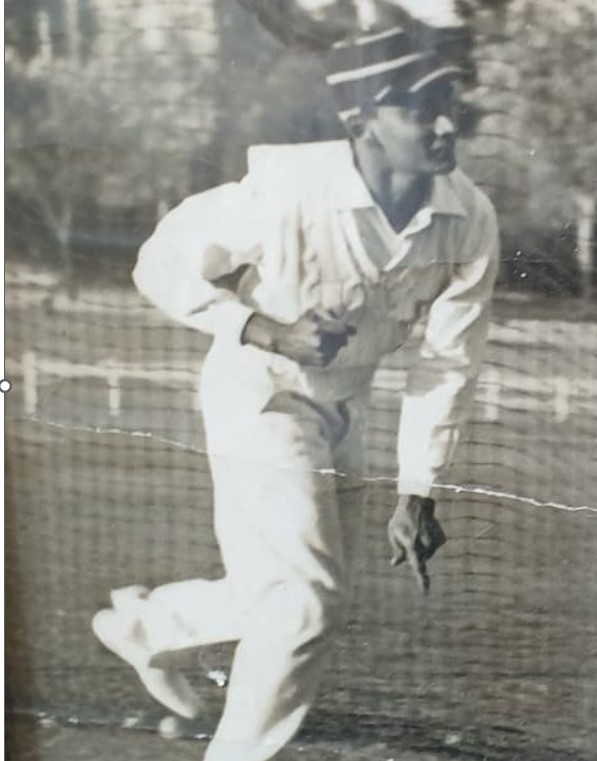

M. Sivanathan – Royal College Skipper 1937 and Vice-Captain to Ryle de Soysa in 1936.
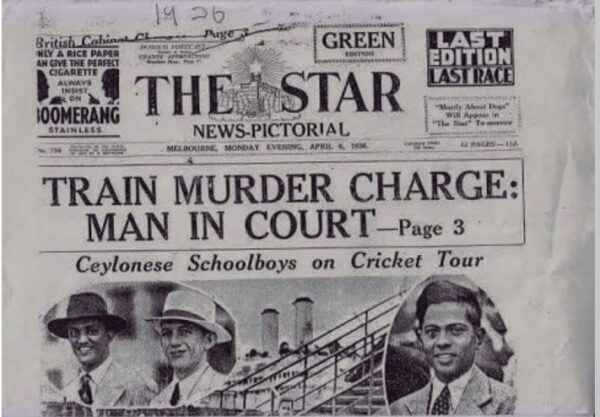

Extracts from the article ‘An Unique Event: The Royal College Tour of Australia in 1936’ by Senaka Weeraratna
- The Royal College First Eleven Cricket Team tour of Australia under the captaincy of Ryle de Soysa in 1936 has a unique place in world cricket History. It was the first cricket team from an Asian country to visit Australia (at whatever the level of cricket). I wrote this article based on research gleaned mainly from the memoirs of Lucien de Zoysa entitled ‘ My First Love’ – published in the Sunday Observer (May 2, 1993).
*In 1936, a schoolboy cricket team from Sri Lanka, Royal College, Colombo toured Australia and played 5 matches altogether in Perth, Adelaide and Melbourne. This visit is now regarded as the first cricket tour of Australia by a team from an Asian country. They came at the invitation of St. Peter’s College of South Australia which had sent a schoolboy cricket team to Sri Lanka in 1928.
*Pat McCarthy, who migrated to Australia in 1948 from Sri Lanka represented Western Australia in Sheffield Shield cricket.
- Royal College played against Melbourne High School in Melbourne in a memorable match in 1936 which saw two players from the two teams outshining everyone else. The two were Pat McCarthy from Royal College and Keith Miller from Melbourne High School, both of whom were to become iconic and legendary in cricket folk lore. The Headmaster of Melbourne High School then was W.M. Woodfull, Australia’s Test Cricket captain. Don Bradman was a member of the Australian Test Cricket team under the captaincy of W.M.
- An interesting quote is the remark made by M. Woodful to Major L.V. Gooneratne in an
answer (to a question) that ‘your McCarthy is as good or even better than (Keith) Miller’.
Royal College team toured Australia in 1936
by A.C. De Silva (Sunday Observer, 17 March 2013)
FLASHBACK: The year 1936 was an outstanding year for Royal in their cricket history. It was a historic year for Ceylon Schools Cricket.
For the first time in the annals of Ceylon Schools Cricket, a school’s team toured a foreign country
– Australia. The team that toured Australia was the Royal College team after their 57th Royal- Thomian cricket match played at the NCC Grounds.
The Royal team that went on tour comprised G.R.J. De Soysa (Captain), W.B.V. Thiedeman, D.R. Vollenhoven, E.F.E. De Kretser, F.H. De Saram, S. Pathmanathan, P.J. ‘Keo’ de Saram, M. Sivanathan, Pat McCarthy, D.R.R. Porritt, L.E. De Zoysa, R.L. De Kretser, S. Coomaraswamy.
When the Royalists played against Melbourne High School, they faced one Australian by the name of Keith Miller – then a tiny fellow not more than 14 years. In that match, Keith Miller did not score many runs, but the Australian captain and Principal of Melbourne High School, Bill Woodful, said Miller had the talent and that one day he would play for Australian team and it came true.



On Royal’s tour of Australia, Lucian de Zoysa was Royal’s opening batsman and he never bowled a ball except at the nets when he would try his hand at leg-spin. Clarrie Grimmett – the Australian leg spinner, having observed this asked Royal’s captain Ryle de Zoysa where he fitted into the team. He was told that Lucien de Zoysa should bowl leg-spin. Lucian, quick on the uptake, took his advice and became first change bowler for his school, club and for All-Ceylon for several years to come.
1936 ROYAL-THOMIAN (57th Encounter) SCOREBOARD
Captains: Ryle de Soysa (Royal); Donald Fairweather (STC)
| S.THOMAS’ COLLEGE 1st INNINGS | |||
| W. Jayatilleke lbw b Thiedeman | 02 | ||
| N. Scheffer lbw b Pathmanathan | 05 | ||
| D. Bartholomeusz b Pathmanathan | 04 | ||
| D. Fairweather b Pathmanathan | 02 | ||
| N. Siebel not out | 151 | ||
| S. Thabrew c Sivanathan b De Soysa | 20 | ||
| C. Cotelingam b De Soysa | 05 | ||
| R.B. Wijesinha c De Seram b Pathmanathan | 57 | ||
| D. Caldera lbw b Thiedeman | 00 | ||
| S. Anthonisz c De Saram b Sivanathan | 15 | ||
| G. Weeratunga c De Saram b Pathmanathan | 05 | ||
| Extras | 20 | ||
| Total | 286 | ||
| Fall of Wickets:1-9,2-15, 3-15, 4-19, 5-59, 7-201, 8-202, 9-269 Bowling: (Royal): | 6-65 | ||
| W.B.V. Thiedeman | 18-1-59-2 | ||
| S. Pathmanathan | 13-3-27-3 | ||
| E.F.E. de Kretser | 10-0-36-0 | ||
| M. Sivanathan | 19-4-47-1 | ||
| G.R.J. De Soyza | 11-1-46-2 | ||
| D.R.R. Porritt | 2-0-21-0 | ||
| P.C.D. McCarthy | 4-0-16-0 | ||
| L.E. de Zoysa | 5-0-14-0 | ||
| ROYAL COLLEGE 1ST INNINGS | |||
| L.E.de Zoysa st. Bartholomeusz b Weeratunge | 27 | ||
| D. Vollenhoven c Siebel b Weeratunge | 26 | ||
| E.F.E.de Kretser c and b Weeratunge | 34 | ||
| F.H. De Saram c Fairweather b Anthonisz | 25 | ||
| P.C.D. McCarthy lbw b Anthonisz | 98 | ||
| G.R.J. De Soysa lbw b Fairweather | 23 | ||
| W.B.V. Thiedeman c Bartholomeusz b Fairweather | 11 | ||
| U.T. Perera lbw b Anthonisz | 20 | ||
| M. Sivanathan not out | 09 | ||
| D.R.R. Porritt not out | 01 | ||
| Extras | 15 | ||
| Total (for 8 wkts dec) | 289 | ||
| Did not bat: S. Pathmanathan Fall of Wkt: 1-49, 2-60, 3-96, 4-165, 5-224, 6-246 | |||
7-271, 8-283
Bowling: (S. Thomas’)
| S. Thabrew | 11-4-21-0 |
| S. Anthonisz | 41-14-59-3 |
| R.B. Wijesinha | 18-2-42-0 |
| D. Caldera | 7-2-15-0 |
| D. Fairweather | 16-2-33-2 |
| G. Weeratunge | 28-3-101-3 |
| C. Cotelingam | 4-2-3-0 |
| S.THOMAS’ COLLEGE 2ND INNINGS | ||
| W. Jayatilleke not out | 72 | |
| N. Scheffer not out | 54 | |
| Extras | 8 | |
| Total (for no wkt – dec) | 134 | |
| Bowling: (Royal): W.B.V. Thiedeman | 6-0-28-0 | |
| S. Pathmanathan | 8-3-20-0 | |
| E.F.E. de Kretser | 6-1-13-0 | |
| M. Sivanathan | 9-1-23-0 | |
| G.R.J. De Soyza | 5-0-26-0 | |
| L.E. de Zoysa | 3-0-16-0 | |
ROYAL COLLEGE 2ND INNINGS
L.E.de Zoysa not out 21
- Vollenhoven c Bartholomeusz b Weeratunge 05
| E.F.E. De Kretser not out | 05 | |
| Extras | 01 | |
| Total (for one wkt) | 32 | |
| Fall of Wkt: 1-17 Bowling: (S. Thomas’) S. Thabrew |
2-1-1-0 | |
| S. Anthonisz | 7-1-11-0 | |
| R.B. Wijesinha | 6-2-5-0 | |
| D. Fairweather | 2-0-3-0 | |
| G. Weeratunge | 7-1-11-1 | |
| Result: Match Drawn |
17 February 1999 – Wally May
Who was the first Sri Lankan to play representative cricket in Sri Lanka, before it achieved test status, and also play Sheffield Shield cricket in Australia?
This sounds like one of those trivial questions the Australian television channel broadcasting the one-day matches puts to its viewers. Except that with regard to the above question, the achievements of Pat McCarthy are far from trivial.
*Now Pat McCarthy (79) lives alone in Perth-his wife died 11 years ago-surrounded by memorabilia. Because of a bad knee he was not able to accept an invitation to attend the ceremonial presentation of a bat by the Chairman of the Board of Control of Cricket in Sri Lanka (BCCSL) to the West Australian Cricket Association (WACA) on January 28. The bat was autographed by members of the Sri Lanka team that won the World Cup in Lahore in 1996.
McCarthy was missed at the ceremony since he is the oldest living link in cricket between Australia and Sri Lanka. With this presentation at the WACA grounds in Perth-Pat’s old home ground-it would be singularly appropriate to recall Pat’s outstanding record as a cricketer. Pat has made an invaluable contribution to the sport as well as to furthering Australian-Sri Lankan relations. His achievements highlight for the present generation a great Sri Lankan sportsman, a worthy exponent of the noble game of cricket from an earlier era.
More than six decades ago, McCarthy had begun showing his prowess on the cricket ovals of Colombo. Such was his cricketing ability that in 1935, at the age of 15, he was selected to play for Royal College. In 1936, McCarthy was included in the Royal College eleven captained by Ryle de Soysa, that toured Australia-the first by an Asian team at any level of cricket – and in 1938 he captained the College team.
McCarthy was his team’s highest scorer on the Australian tour. the legendary cricketer Bill Wood fully judged him at that stage to be a better batsman than Keith Miller.
In 1938-18 years old and still a schoolboy, McCarthy (at that time captain of Royal) was chosen to play for Ceylon against the Australian Test team led by Don Bradman. He batted in the coveted No. 4 position. Stan McCabe captained Australia in this particular match and Hassett and Badcock scored centuries for the visitors.
Those were the years when Australian and English teams travelled by ship and were glad to go ashore in Colombo to shake off there sea legs by playing a one-day match against the Ceylon side In the 1938 match, McCarthy showed his fielding skills by caching both openers – Fingleton and Brown – on the boundary.
Pat continued his cricket career with great success with the Nondescripts Cricket Club (NCC) and is considered by many to have been the finest batsman to play for the Club. This is despite the great array of top-flight NCC batsmen who have represented Sri Lanka over the past several decades. His favourite strokes were the hook and the straight drives on both sides of the wicket. In the ten or so years prior to his departure for Australia in 1948, Pat amassed a veritable mountain of runs scoring two double centuries, ten centuries and over fifty half centuries in A division cricket. His outstanding record for the Club has prompted a leading cricket scribe to liken Pat to be to the NCC what M. Sathasivam was to the Tamil Union and Sargo Jayawickreme to the SSC.
It is interesting to note that Pat’s marriage to his wife Yvonne linked him to the Kelaart family – a family that has produced many Sri Lankan sportsmen of note in cricket, hockey and other sports. Pat’s cricketing prowess also earned him recognition in India. In 1939, he was one of two Sri Lankans invited to play for “The Rest” in India’s Pentangular tournament. The other four participating teams were the Hindus, Muslims, Parsees and Europeans.
One of Pat’s most vivid recollections of the Tournament was Lala Amarnath’s double century for the Hindus against “The Rest”. Amarnath was garlanded by spectators each time he scored fifty runs. Six years later (1945) Vijay Merchant’s Indian cricket team visited Sri Lanka and Pat scored a scintillating 88 runs against a formidable attack that included Amarnath, Mankad, Bannerjee and Rangachari. The innings was made more memorable by two towering sixes that thundered onto the stadium roof.
Though cricket was the sport at which Pat excelled, his sporting interests in Australia were by no means confined to cricket, the “summer game”. He also participated at a competitive level in athletics, golf, rugger, soccer, swimming and tennis. In this regard, Professor Tony Barker of the University of Western Australia in Perth, cricket buff and historian of the WACA, after a recent interview with Pat, speaks of his “remarkable all around skills.” Indeed, it would not be an exaggeration to claim that Pat was one of the most versatile sportsmen the island of Sri Lanka has produced.
Pat’s departure for Perth in Western Australia in 1948 was prompted, among other considerations, by reasons of health. It did not, however dim his enthusiasm for sport. Despite Sri Lankan cricket not enjoying the high profile and reputation it does today, by ability, talent and sheer weight of performance, Pat had the unique distinction of being one of the Asian-Australians to secure a place in the West Australian Sheffield Shield team (1951-53). Incidentally, this team was captained by Keith Carmody whom Pat had met in Sri Lanka when Carmody was a member of the touring Australian Services team.
Pat played from 1948-60 in the Perth metropolitan cricket competition: the first three years under Carmody before moving to other clubs between 1951-60, all of which recognised his leadership qualities by making him captain.
Perhaps 1951 was Pat’s most successful cricketing year in that during this season he amassed a total of 980 runs in inter-state and Perth metropolitan competition cricket. One memorable inter-state performance was his 88 against the State of South Australia. For this performance he had the rare honour of being personally congratulated for his stroke play by no less a person than Sir Donald Bradman. Another outstanding achievement of Pat was his 98 against the State of New South Wales in Sydney when he had to battle with cricketing giants like Miller, Lindwall, and Benaud who were in their prime.
Pat recalls in this interview with Professor Barker that he was only two runs short of this century when he was trapped leg before wicket by a Benaud top-spinner.
Professor Barker also notes that the former Australian national selector Lawrie Sawle and others leading Australian cricketers to remember Pat as an exciting batsman always out to wrest the initiative with bold aggression-a Sri Lanka cricketing trait immortalised by the likes of Sathasivam and recently by Sanath Jayasuriya.
When Pat retired from cricket in 1960 he returned to another of his loves-golf. In 1962 he achieved every golfer’s dream of a hole-in-one and during his serious golfing years played with a handicap of three. Living in retirement in Perth, Pat has one son living 15 minutes away and their other in Sydney. Though he is not in the best of health, he still has a wealth of memories and good friends to sustain him.
Cricket is often referred to as a gentlemen’s game and this above all personifies Pat as a cricketing gentleman of outstanding ability and character. He brought into his cricket-as he does to his life-a sense of fairness, common sense, charm and modesty which ensures the respect of his fellowmen. He has been over the years, as many have observed, a great unofficial ambassador for Sri Lanka in Australia. He has always been a firm supporter of Sri Lankan cricket and rendered great
assistance to visiting Sri Lankan teams. In the cricket arena, he has been a trailblazer for Sri Lankans in Australia followed notably by Malcolm Francke in Queensland and Dav Whatmore who played for Victoria and Australia.
In anyone’s language, Pat McCarthy was indeed a Cricketer extraordinary.
Source: Daily News (http://www.lanka.net)
* Pat married Yvonne Kelaart in Colombo in February 1942. They had two sons. Yvonne died in 1988, and Pat passed away on 23rd December 2007, aged 88.
* Pat was a versatile sportsman at Royal, where he excelled as an athlete in events like the pole vault, long jump and sprints. At tennis he was adjudged the National Juvenile Tennis Champ and was as well a swimmer of repute. But by far his strength lay in cricket, he was very inch a cricketer. Evidence of this was seen in his mannerism and approach, that was suggestive of one oozing with talent for the game. Pat McCarthy represented Royal College at cricket from 1935 to 1938.
Those were the glamorous years of cricket, where each school had star studded sides to be very competitive – with a good crop of fair complexioned cricketers, who with the red cherry (cricket ball) in their hands against the green sward, made things look ever so colourful to be picturesque and drew large crowds to witness matches.
Pat was a prodigious right hand bat, was a prolific run getter, scoring freely against most schools, to become a household name. He figures in four Royal-Thomian cricket encounters, where on his debut in 1935 under A. N. Dharmaratne he made 54. S. Thomas’ captained by Donald Fairweather won by 153 runs.
In 1936 Royal was led by Ryle de Soysa with S. Thomas’ skippered by Donald Fairweather, the match was left drawn, with Pat making 98 and Thomian Norman Siebel establishing a record, scoring an unbeaten 151.
- Sivanathan led Royal in 1937 while Willie Jayatilleke captained S. Thomas’ scoring 62 and 110 not out. Pat didn’t do much in both innings and S. Thomas’ won by 3 wickets.
In his final year in 1938 Pat led Royal with Bertie Wijesinghe captaining S. Thomas’. Royal did well to make 351 for 7 with Pat making a parting 81. S. Thomas’ made 112 and 152 and lost by an innings and 87 runs.
– Richard Dwight (extract from Daily News 07.01.2008)







